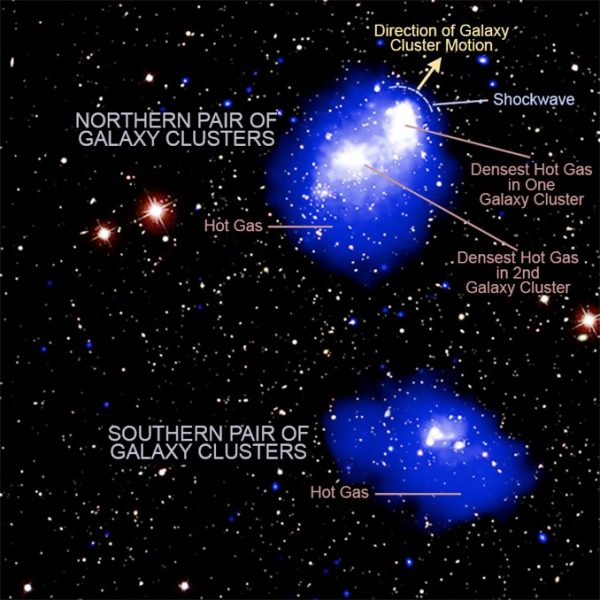Four galaxy clusters merging in colossal collision – Astronomy Now Online

Four huge galaxy clusters, each with a mass of at least several hundred trillion times that of the sun, are in the process of merging to form one of the most massive systems in the known universe.
Known collectively as Abell 1758, the system consists of a northern pair of galaxy clusters and a southern pair some 3 billion light years from Earth, each embedded in vast clouds of hot gas and permeated by even larger amounts of unseen dark matter. The two galaxy clusters in each pair are themselves in the process of merging.
“Abell 1758 is a galaxy cluster system that was originally discovered as one single cluster, but follow-up observations showed it to consist of two separate clusters: one northern and one southern, separated by about 6 million light years,” astronomer Gerrit Schellenberger writes in a blog posting hosted by the Chandra X-ray Observatory.
Using Chandra, Schellenberger and his colleagues were able to detect a shock wave in the hot gas surrounding the two members of the norther pair, allowing then to determine the two clusters are moving at a relative velocity of 3 million to 5 million kilometres per hour (1.8 million to 3.1 million mph).
The Chandra data also provided an indication of how long the mergers have been underway by showing how heavy elements are dispersed and redistributed. In the northern galaxy pair, that disruption is pronounced, indicating the merger process is well underway. In the southern pair, heavy elements remain concentrated near the centres of each galaxy as the two cores pass close together, indicating a merger still in its opening stages.
“Both of these clusters show indications that they are themselves still forming through their own strong mergers between two smaller galaxy clusters,” Schellenberger writes. “More recently, the violent merger in the northern cluster has been confirmed, and the southern cluster seems to be in an earlier stage of merger. Eventually, the northern and southern clusters will also collide, so the whole system is a quadruple merger, which makes this a uniquely interesting case to study.”





